What happings when they engrave a nickle colt ? Do they have to replate it ? or do the just seal the engraved part ? Any idea of cost ? I know some of you hjave had engraving done . How about some pictures and costs ...Please Thanks , Larry

vagabond88
Thinking about engraving my pair of Nickle SAA
vagabond88
Discussion starter
163 posts
·
Joined 2011
- Add to quote
What happings when they engrave a nickle colt ? Do they have to replate it ? or do the just seal the engraved part ? Any idea of cost ? I know some of you hjave had engraving done . How about some pictures and costs ...Please Thanks , Larry
20,040 posts
·
Joined 2001
Because the nickel will chip and flake off if you attempt to engrave the gun, the engraver will usually send the gun out to have the nickel stripped off.
After engraving, he'll send it back out to have a new nickel finish plated on.
Some engravers may have the equipment to do the stripping in their shop, but due to the problems with getting a good plating, most will send the gun to a professional plater to have it re-applied.
After engraving, most will offer on request "inking" of the engraving.
In this process an ink type material will be put in the engraving to highlight it and the parts will be baked to "cure" the ink.
This makes the engraving "pop out" better and adds to the appearance.
Cost of the engraving depends entirely on what you want and who you pick to do it.
The more coverage the higher the cost. As example Colt offer engraving in grades of A, B, C, and D, with each level covering more of a percentage of the gun. "D" is full coverage and costs the most.
Above "D" from Colt is signed engraving, done by one of Colt's top people who sign the work. Other than including gold or other precisious metal inlays, this is the top of the line.
Cost also depends on who does the work. An engraver with little to no reputation will be cheaper than a nationally known Master.
Last, the quality will count toward cost. A poor engraver will usually cost less than a Master, and will usually look bad to anyone who knows engraving.
One option to boost the value would be to have the Colt factory do the work, since factory work will be worth more than >comparable< quality work done a non-factory engraver.
Last, you have to decide what style of engraving you want. Typical choices are American Scroll and the styles done by Colt's famous German engravers of the 1800's.
The only limits on engraving are how much you can spend.
Colt's web site has full details on their engraving services:
Custom Firearms
After engraving, he'll send it back out to have a new nickel finish plated on.
Some engravers may have the equipment to do the stripping in their shop, but due to the problems with getting a good plating, most will send the gun to a professional plater to have it re-applied.
After engraving, most will offer on request "inking" of the engraving.
In this process an ink type material will be put in the engraving to highlight it and the parts will be baked to "cure" the ink.
This makes the engraving "pop out" better and adds to the appearance.
Cost of the engraving depends entirely on what you want and who you pick to do it.
The more coverage the higher the cost. As example Colt offer engraving in grades of A, B, C, and D, with each level covering more of a percentage of the gun. "D" is full coverage and costs the most.
Above "D" from Colt is signed engraving, done by one of Colt's top people who sign the work. Other than including gold or other precisious metal inlays, this is the top of the line.
Cost also depends on who does the work. An engraver with little to no reputation will be cheaper than a nationally known Master.
Last, the quality will count toward cost. A poor engraver will usually cost less than a Master, and will usually look bad to anyone who knows engraving.
One option to boost the value would be to have the Colt factory do the work, since factory work will be worth more than >comparable< quality work done a non-factory engraver.
Last, you have to decide what style of engraving you want. Typical choices are American Scroll and the styles done by Colt's famous German engravers of the 1800's.
The only limits on engraving are how much you can spend.
Colt's web site has full details on their engraving services:
Custom Firearms
11,498 posts
·
Joined 2009
you might also try satin nickel or "french gray". Check out the guns that swamprat posted in this thread. The engraving is really nicely highlighted
http://www.coltforum.com/forums/colt-revolvers/55556-two-colt-revolver-projects-continue.html
Also check out how Muddyboots came out in satin nickel. They look amazing.
http://www.coltforum.com/forums/colt-revolvers/55556-two-colt-revolver-projects-continue.html
Also check out how Muddyboots came out in satin nickel. They look amazing.
2,407 posts
·
Joined 2011
I have had engraving done. First you have to decide what type of engraving you want then how much coverage you want then the finish. If your looking to re-nickel it it shouldn't be a problem. I had a 44-40 which was nickel and I had it C+ coverage almost a D level and had it silver plated which came out real nice and had Ivory grips with a naked girl carved on the grip. It ran me $2500 when said and done. I ended up selling the gun but wish I hadn't. It also depends on the Engraver who does the work and what they charge. Some want you to strip and prep the gun before you send it out to them and after its done they will send it back to you so you can send it out and have it refinished. I posted some of mine on the Photo Gallery and started a thread for engraved SAA. check it out. I have a few more that I haven posted. If you send it out to Colt it is going to cost you much more maybe double the amount. John Adams Engraving did mine and they came out incredible. He will do the hole thing for you if you send him the gun and you won't have to worry about anything but the payment. When you get it back it will be the way you wanted it.
11,776 posts
·
Joined 2008
I had a freind who had a matched pair of nickel Colt SAA's engraved deeply right through the nickel, then left that way. They were gorgeous. When I ran my fingers across the engraving, though, I could feel the sharper edges of the engraving. I didn't see the guns after they were shot or know the integrity of the nickel afterwards if it flaked off or not. I think the engraver probably did a subtle polishing job on the nickel, though. I just felt it would have been more course to the touch. But again, the guns were beautiful when I saw them.
vagabond88
Discussion starter
163 posts
·
Joined 2011
Hey Wyatt.. We should meet , I live in Georgetown .. one hour out of Sacto ... And thank you everyone for your ideas...Larry
4,349 posts
·
Joined 2006
If it were me, I would buy a used NIB engraved gun. Let the first guy lose the engraving cost. The cost of stripping, engraving, replating would be high, and you never know how it will turn out. Engraved modern guns sell for a lot less than what the original owner paid, they are not an investment if you pay the original cost. I just sold a NIB Colt SAA factory B engraved with Ivory grips for $2500 on the internet. I tried higher, but no bids. The cost if bought new would be about $4000. This is typical from what I have seen.
3,897 posts
·
Joined 2006
If you shop around, you can buy an engraved gun for what it will cost you to have one engraved.
This gun was not nickel plated, the engraving and nickel plating was $2600 at Nutmeg:
![Image]()
![Image]()
I paid $2000 for this one on GB without the MOP grips:
![Image]()
![Image]()
I paid $2500 for this one at a local gunshow:
![Image]()
![Image]()
I paid $2000 for this one on GB:
![Image]()
![Image]()
I paid $2600 for this one with the carved Ivory grips from a dealer:
![Image]()
![Image]()
This gun was not nickel plated, the engraving and nickel plating was $2600 at Nutmeg:
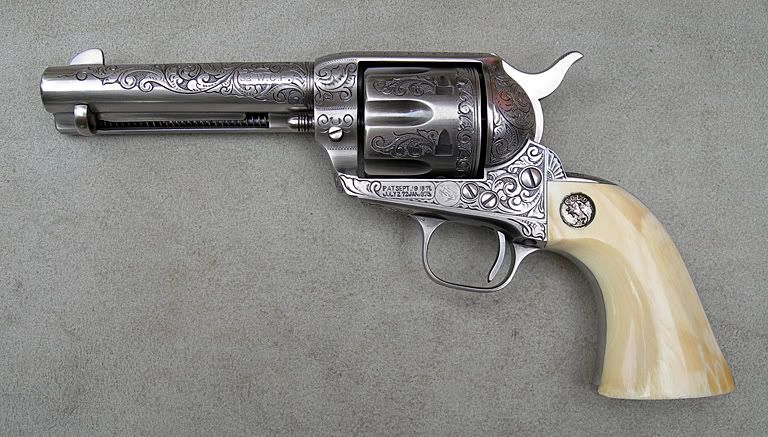
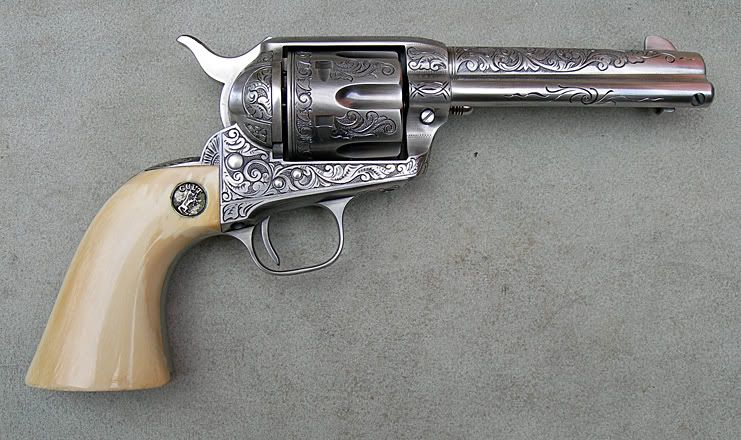
I paid $2000 for this one on GB without the MOP grips:
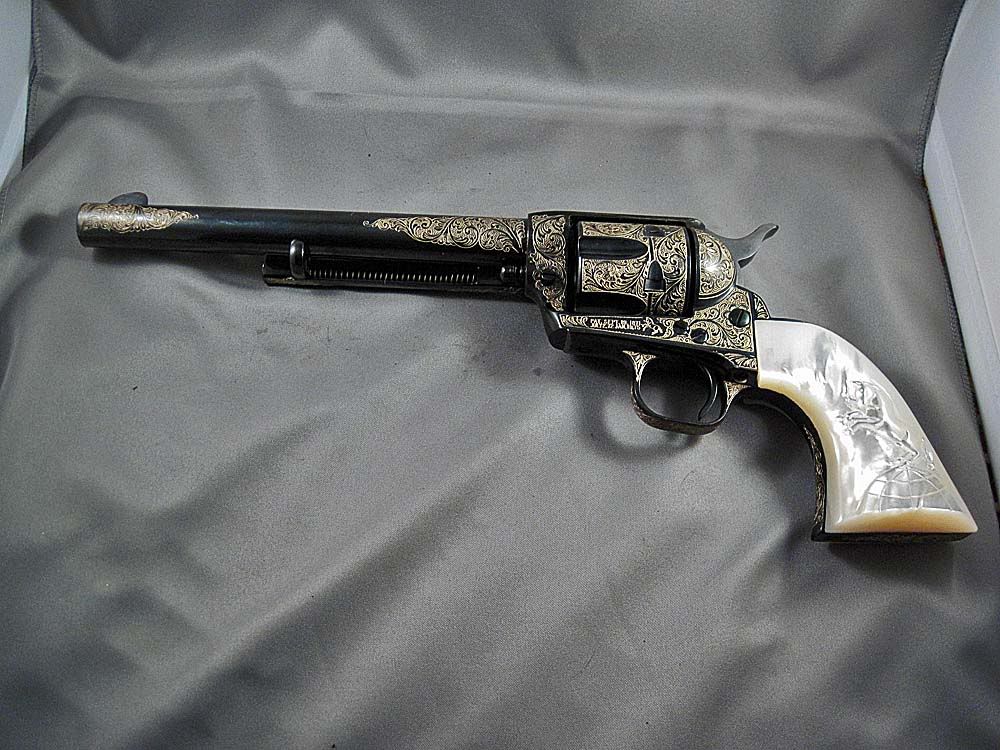

I paid $2500 for this one at a local gunshow:
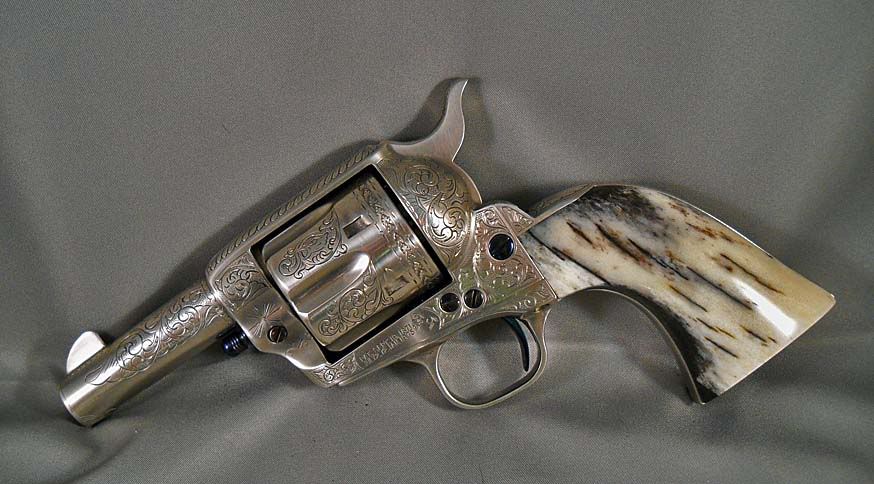
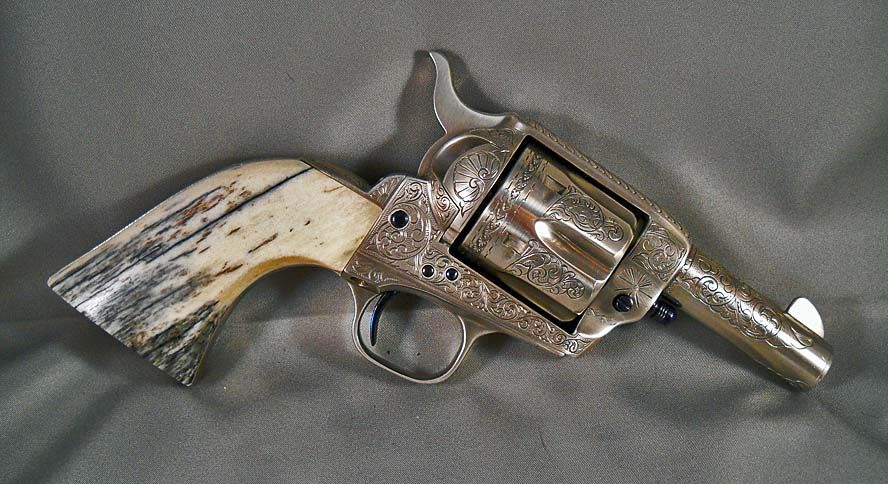
I paid $2000 for this one on GB:
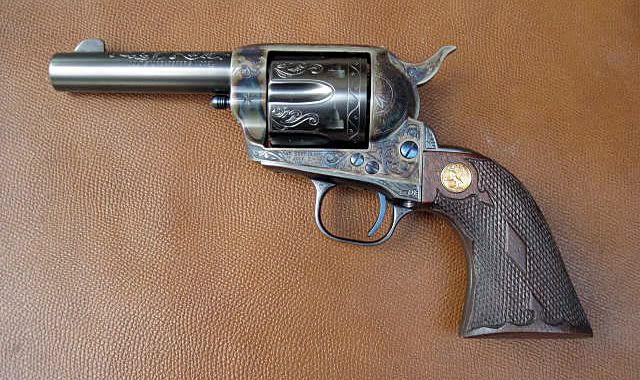

I paid $2600 for this one with the carved Ivory grips from a dealer:
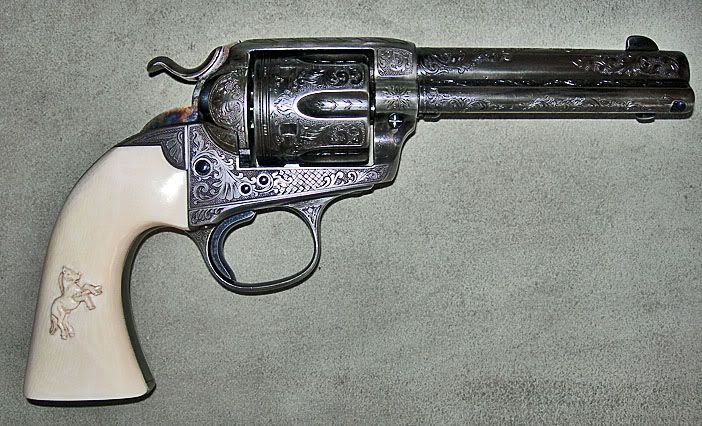
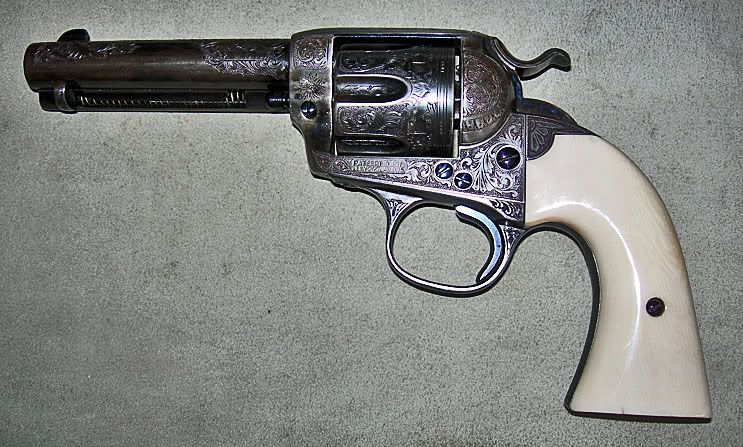
2,407 posts
·
Joined 2011
Well I have to say, that there is some fancy smoke wagons. You absolutely got a deal on them. You have to realize one thing. Nutmeg sports is a dealer. He buys a SAA $1050 0r $1100 bucks, mails it to the engraver $35, engraver work $1000 to $2000 depending on coverage, Plating what ever Nickel,Silver $150. Blue and Case Color $300 since it is two jobs. Ivory $500 and mail back $35. Add it all up and you have you Gun then he tacks on his sure charge. Say $1100 + $2000 +$150 +$500 +$70 = $3850 + sure charge of $600 = $4450. There is your Nutmeg Price. That is his business and he does a great job. He never has any guns left over they just fly off the shelf. I did all this myself and saved $600 bucks. You can even send him the gun and he will do it for you.
2,407 posts
·
Joined 2011
I also believe it is the caliber as well. everyone wants 45 Long Colt. The other calibers are harder to sell. Just look at the sights they are all off calibers.
4,349 posts
·
Joined 2006
It will still be an after market engraved gun. When people see an engraved Colt, their first question usually is "is it factory engraved". There is something special about owning a factory engraved Colt.
2,407 posts
·
Joined 2011
Yes you are right. People always want to know. It just tells them you over paid. I have a factory engraved Colt and after buying that I found out when I cut out the middle guy I save a great deal of money which I can add a higher level of engraving to my gun. For a price of a B engraved Colt I can get a C level gun if I have it done on my own. These are facts. I have done this several times.
5,858 posts
·
Joined 2010
In the spirit of "show & tell" -- my SAA I engraved. I know it isn't in the same league with the professional engraving artists but if I wanted an engraved gun I had to do it myself. I bought Meeks' book on gun engraving and followed it religiously. This is my second job. I never planned to become an engraver but had to learn something about it for my business in restoration of early (pre 1800) guns. Weld a part, replace a part, it had to match the original. Great satisfaction in DIY, something like mother-love, you carry the kid, have the kid, you love it.
![Image]()
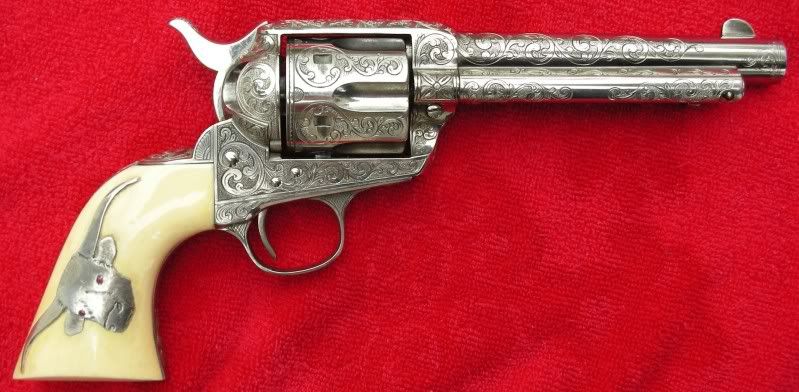
2,407 posts
·
Joined 2011
Hey rhmc24, that looks GREAT! Great job on that. I like it a lot. It doesn't take much just time and effort and willing to learn. I'm not an Engraver myself but soon as I retire in 5 years from my job this is what I'm going to take up. Again I have to say a great job.
-
?
-
?
-
?
-
?
-
?
-
?
-
?
-
?
-
?
-
?
-
?
-
?
-
?
-
?
-
?
-
?
-
?
-
?
-
?
-
?
- posts
- 2M
- members
- 64K
- Since
- 2000
A forum community dedicated to Colt firearm owners and enthusiasts. Come join the discussion about performance, gunsmithing, troubleshooting, reviews, accessories, classifieds, and more!
Explore Our Forums




